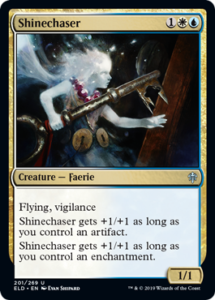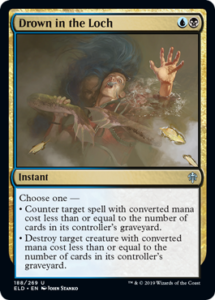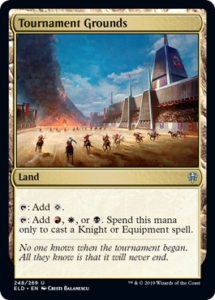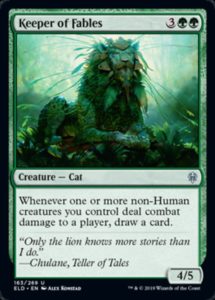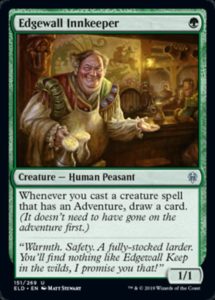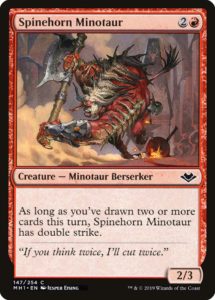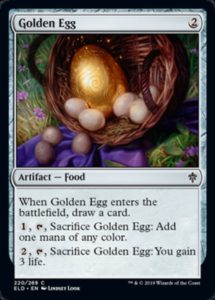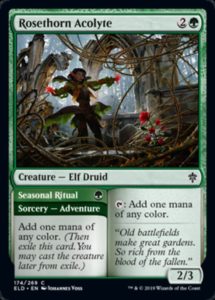Hey, everyone! Throne of Eldraine prerelease is this weekend and it’ll be on Arena even sooner, so we’ve got a pretty massive article for you to digest throughout the week. Today we’re going to cover every archetype in the set by color pair. There’s a ton to get through, so let’s get going!
WU—Artifacts and Enchantments matter
This archetype, like many in this set, is rather broad. There are several ways cards care about artifacts and enchantments, but the most common is a Threshold 1 mechanic—where a card powers up if you control a single artifact or enchantment. Some cards power up even more if control both an artifact and an enchantment.
Signpost Uncommons: Each color has two signpost multicolor uncommons: a hybrid card (that can go into a heavy monocolor deck but works best in its color pair) and a multicolor card (that more specifically wants to be in the color pair). For WU, they are Arcanist’s Owl and Shinechaser. Arcanist’s Owl is a great, modular card that you’ll always play if you can reliably cast, since it’s a Phantom Monster that occasionally brings along Trapped in the Tower* or Charmed Sleep). Shinechaster, on the other hand, is unplayable if you don’t control an artifact or enchantment, is serviceable if you control one, and excellent if you control both.
*Fun fact: The only way to escape being Trapped in the Tower is to get help from a Faerie Guidemother.
MVPs: Aside from incredibly powerful cards like Arcanist’s Owl, perhaps the most important cards are Trapped in the Tower and Charmed Sleep. Sure, everyone in these colors wants them, but you need them because they’re enchantments that stick around and power up your cards.
Enablers: WU is an A+B archetype (technically an A+B+C, since you want artifacts, enchantments, and things that want both), so ideally you can find cheap artifacts and enchantments to get your deck going. Witching Well and Mantle of Tides are the cards to enable super-aggressive starts with Flutterfox, and Wishing Well in particular will both find you pieces you need and randomly trigger blue’s second-card-matters mechanics. I’d also keep an eye on Fortifying Provisions—it’s not a very powerful effect, but it nevertheless gives you both an enchantment and an artifact in a single card.
Overall: WU is an exciting archetype. The hoops aren’t that difficult to jump through, but they’re presumably sufficient that everyone at the table won’t be snatching up Shinechasers. There are a variety of ways it can work, such as all-in All That Glitters decks, only artifacts-matter, or general goodstuff decks, and I’m excited to see all that is possible.
It’s worth noting that there is also an artifacts-matter theme that eschews enchantments completely. Animating Faerie and Emry, Lurker of the Loch are two prime examples. This makes sense, since enchantments are much more difficult to come by than artifacts (Food is a plentiful artifact—but not in blue, which can only make it with Turn into a Pumpkin).
UB—Both Graveyards matter
Like WU, this archetype is rather broad. However, unlike WU, it’s inconsistent about what it rewards you for doing and is liable to punish you for filling the wrong graveyard at the wrong time. Graveyard themes have proven difficult to balance for Limited without break Constructed, and Throne of Eldraine follows this trend. Spending a card to mill someone is inherently dangerous, since unless you’re getting at least an extra card’s worth out of value from the effort, you’re losing card advantage.
Signpost Uncommons: Drown in the Loch is an awful card when not enabled and an insanely efficient card when turned on. Two mana to counter a spell or kill a creature is an amazing rate. Covetous Urge is a very powerful spell, as well—it lets you pluck any nonland card from an opponent’s hand (or failing that, graveyard) and cast it (you do still need to pay for it, but it does fix your mana). At its best, it’s a 2-for-1 that takes a card from your opponent’s hand and lets you cast it, and even if they have no targets, it still lets you tutor for the best card in your opponent’s graveyard. There’s a lot of power here and both cards are consistent in wanting your opponent to have a full graveyard.
Enablers: There are no repeatable, easy-to-use mill cards at common, like Merfolk Mesmerist. To actively mill your opponent, you’ll need to catch them with Didn’t Say Please, stick an early Eye Collector (probably the most important enabler), or suffer playing Merfolk Secretkeeper (a combination of very two underwhelming cards, Tome Scour and Kraken Hatchling). Unless you get lucky and play an early, uncontested Eye Collector, there aren’t a ton of easy ways to quickly fill graveyards at common. Sure, there’s the powerful and expensive Syr Konrad, the Grim, but he’s an above-rate card that every black player is liable to want.
While the signpost uncommons reward filling your opponent’s graveyard, many cards reward you for filling you own. To name a few, there’s Barrow Witches, Festive Funeral, Mystic Sanctuary, Cauldron Familiar, Cauldron’s Gift, Order of Midnight, and Once and Future. These cards can punish you for filling your opponent’s graveyard. Imagine casting Venture Deeper (Merfolk Secretkeeper‘s Adventure) and then giving your food-rich BG opponent a Deathless Knight, or finding them their Feasting Troll King. You need to be very cautious or very lucky when choosing who and when to mill or you might make your opponent’s deck better.
MVPs: Eye Collector. It’s a high risk card (it dies to all removal, can easily be blanked by any flier, and might enable your opponent’s shenanigans) that stocks both graveyards quickly.
Overall: I’m very suspicious of UB mill. When things go well, your deck will look powerful for having multiple Drown in the Lochs that are always on, but there are so many ways for things to go poorly. Sometimes you’ll mill your opponent and give them free cards while draining yourself of resources. Sometimes you’ll mill yourself and accelerate your opponent’s Into the Story. Sometimes, you’ll just have a pile of mediocre cards and throw away card advantage to turn on Drown in the Loch, which as a 1-for-1 is never going to recoup the card disadvantage you incurred. There simply isn’t a singular, over-the-top card like Rise from the Tides or Spider Spawning to reward a focused strategy; instead, UB is a skill-testing archetype that might be missing the pieces it needs to be consistent, coherent, and powerful.
WBR—Knights matter
These three color pairs all care about knights. There are subtle distinctions between them all, but they all reward assembling your own Camelot. BR theoretically has an equipment theme, but Steelclaw Lance is the only non-rare card to do so (and it rewards playing knights, not equipment). WB supports a slower, attrition-based strategy on the back of cards like Barrow Witches and Smitten Swordmaster‘s Adventure, Curry Favor. Finally, RW rewards going wide with Inspiring Veteran (although WB’s signpost, Wintermoor Commander, also does that). Interestingly, white has few knights-matter cards at common and uncommon: only Shining Armor and Venerable Knight (the incredibly powerful Garrison Griffin is only in Brawl decks and Collector Boosters).
Signpost Uncommons: This section is going to be a bit longer than the others since we’ve got triple the signposts to cover. Inspiring Veteran and Wintermoor Commander both reward playing a large number of knights, though Inspiring Veteran is definitely the faster and more vulnerable of the two. Steelclaw Lance also rewards playing a density of knights (but is a fine equipment even on a non-knight). The hybrid uncommons communicate some of the differences at play: Fireborn Knight rewards power-pumping, Elite Headhunter plays more of a sacrifice-attrition strategy (which ostensibly is WB’s shtick), and Resolute Rider is a potent, hard-to-kill threat. There are a bunch of micro-synergies that differentiate these three archetypes, but generally you’re going to want to combine a lot of knights with effects that care about knights, aggression, and attrition.
Enablers: Knights are one of the two tribal themes in Throne of Eldraine, so any creature that is a knight or makes a knight is an enabler. There 41 knights available, so you’ve got plenty to choose from. Some, like Ardenvale Tactician and Lost Legion are just good on their own (though not the easiest to cast in a multicolor deck). Others, like Smitten Swordmaster, Raging Redcap, and Youthful Knight are going to be much better if you can power them up (and consequently are much lower picks). The most important enablers are probably the knights-matter cards (especially the signpost uncommons), since they are few but knights are plentiful. The biggest tension is deciding whether you’ll be playing a monocolor, two color, or three color deck, since Lochthwain Paladin, Ardenvale Paladin, and Embereth Paladin (plus the hybrid uncommons) have stringent color requirements.
MVPs: Brimstone Trebuchet could be one of the best cards for any knight archetype—it blocks most fliers and provides a recurring source of damage just as Lobber Crew and Thermo-Alchemist did to great effect. It can turn a board stall into a win or a curve-out into a quick win. Never underestimate a recurring source of damage—Spear Spewer being awful was the exception, not the rule. I’d also pay attention to Crashing Drawbridge. Bloodlust Inciter was astonishingly powerful in hyperaggressive Amonkhet, and this solid blocker turns all of your threats into hasty beaters (effectively giving you a whole mana’s value on all of them).
Overall: It’s not surprising that the Mardu archetypes are the most aggressive nor that they’ve got a tribal component. Knights look quite powerful (especially the red ones) and afford a variety of playstyles. Sure they all trend aggressive, but each color combination can grind out a long game as opponents durdle with Adventures and milling. However, Food presents an existential question: how much will aggressive decks suffer when Food provides every color with incidental lifegain? Can the knights overcome the rush of calories, or will they be unable to overcome the fearsome tide of dinner?
RG(u)—Non-Human matters
The second and final tribal archetype is fairy tale tribal. If your creature isn’t a human, then it’s more powerful than it seems (cards like Lost Legion and Ogre Errant are extra powerful, since they benefit from both knight synergies and nonhuman synergies). This archetype has the fewest synergies of any discussed thus far—there are only 11 cards that reference non-Human creatures.
Signpost Uncommons: Grumgully, the Generous is hilarious and aggressively costed. In the right deck, Grumgully is a three mana 3/3 that permanently buffs all creatures played after them. That’s a whole lot of bang for your buck. Then, there’s Rampart Smasher, the cousin of Sunder Shaman; a big, hard-to-cast, somewhat-evasive stat monster with scant synergy. The messaging is clear: RG wants to play overstatted monsters (Grumgully makes everything into an overstatted monster) and overwhelm the opponent with powerful midrange threats (which RG usually does).
Enablers: As with knight-tribal, there are tons of cards to support this theme. The most important cards to acquire are payoffs like Keeper of Fables and Grumgully, the Generous, very powerful cards that snowball quickly. At common, I’d keep an eye on Rosethorn Halberd—it has the potential to be a much faster Trusty Machete or Pirate’s Cutlass, or it could be Unholy Strength. Sage of the Falls is also worth noting, since it’s a very powerful card (especially in UR) and along with Mistford River Turtle provides some support if you need to drop red or green.
MVPs: Once you’ve got your enablers and generally good cards like Scorching Dragonfire and Outmuscle, you want the best non-Humans you can find, and I’d reach for Seven Dwarves and Fierce Witchstalker. Seven Dwarves has the potential to be an overstatted non-Human two drop (which is perfect for the deck) and Fierce Witchstalker is about as much as green can get for four mana. Dedicated green mages also have access to Garenbrig Paladin (a five mana evasive 5/5 is the perfect curve topper) and Maraleaf Rider (an aggressive threat that benefits from any red knights-matter synergies).
Overall: As is often the case, red-green is the color pair with big, beefy creatures. There isn’t a ton of subtlety or variation here, but it has many of the best 3-5 drops around. The color pair has flexibility in that it can also employ knight tribal, second-card-matters, Food, and ramp, but by and large it wants to play good cards and great cards that make good cards better.
GW—Creatures with Adventures matter
This is a spare but cool archetype. It rewards you for playing lots of creatures with Adventures, but doesn’t reward you for playing the Adventures themselves. With the right uncommons, your cards become far more than the sum of their parts. Alternatively, you can beat down with Garenbrig Squires backed up by Adventure pump spells that become pump spells a second time when played as creatures. You also have the benefit of having an innate long game since Adventure cards can accrue card advantage and provide mana sinks. Lastly, this color pair touches two major set themes—knights and Food—so you can supplement this deck with pieces of other archetypes when necessary.
Signpost Uncommons: Wandermare is quite straightforward. On it’s own, it’s a Centaur Courser, which is above-rate but not stellar. However, with a single questing creature, it grows into a behemoth. It does a good job of communicating the color pair’s theme while also not being so good that other drafters will eagerly snatch it up and splash it. Oakhame Ranger supports the Adventures-matter theme but also encourages a go-wide theme (something which GW tends to do).
Since so much of this archetype exists at uncommon, we’ll include three more cards: Edgewall Innkeeper, Mysterious Pathlighter, and Lucky Charm. Edgewall Innkeeper has an incredibly high ceiling since it comes down early and turns (ideally) a sizable portion of your creatures into cantrips—that kind of advantage is hard to beat. Mysterious Pathlighter is a fine playable that can be white’s answer to Grumgully, the Generous. Finally, Lucky Charm will probably work better in a GU ramp deck, but copying adventures like Lonesome Unicorn‘s Rider In Need or turning Silverflame Squire‘s On Alert into Dauntless Onslaught can be quite powerful.
Enablers: As discussed, many of the actual adventures-matter cards are uncommon. The only common which rewards playing adventures is Garenbrig Squire and not every GW deck is going to really want a bear that sometimes gets to attack as a 3/3. I’d wager that instead the unassuming-looking Shepherd of the Flock is going to be surprisingly potent. It’s a fine aggressive playable (even though he’s both a human and not a knight, denying him access to all tribal shenanigans). Giving you a free Rescue isn’t exciting, but it does let you reuse your Adventures while punishing white and blue’s enchantment-based removal and occasionally saving a creature from removal or Goatnappers.
MVPs: Ardenvale Tactician is fantastic. It’s an aggressively costed, flying knight which will sometimes buy you a little bit of life or enable a big swing. That’s a ton of power on an already solid creature base. They need to be snatched up quickly, however, since every white drafter is going to want them. The big questions I have are how good Lonesome Unicorn and Silverflame Squire are. The Unicorn provides card advantage and helps guarantee you fill out your curve, but at a mediocre rate. The Squire can enable aggressive starts (and is cheap enough to let you go off quickly with Adventures-matter cards), but suffers from being a Goblin Piker with no access to tribal boosts.
Overall: GW is going to be a skill-testing archetype, since you’ll need to properly evaluate when to cast your Adventures and when to just cast the creature halves immediately. I wouldn’t be surprised if this ends up being one of the more Adamant-friendly color pairs, since it can do just fine with only the white or green Adventures-matter cards. However, GW might suffer because several green Adventure cards don’t really do what the archetype wants (Rosethorn Acolyte), are overcosted (Garenbrig Carver), or are too expensive (Tuinvale Treefolk).
UR—Drawing your second card matters
After a lengthy two-month hiatus, this Modern Horizons archetype is finally back. The plan is simple: play a bunch of cards that explode with power as long as you can draw one extra card on your turn. When this works well, your cards will hit well above their weight class as you draw into even more gas. When it works poorly, you’ll draw plenty of air or be stuck with overcosted cards as you desperately quest for an Opt.
Signpost Uncommons: Improbable Alliance is a pretty silly story and looks like a difficult card to enable (basically containing a tiny portion of The Locust God‘s power). However, in the right deck, this is Bitterblossom without the life loss. This is likely to be much more powerful in Constructed than in Limited; but in a dedicated deck, it’s an outstanding threat that protects against flood in the late game and ensures you can draw that precious second card. Loch Dragon on the other hand is simply great and every deck that can play it will play it.
Enablers: As with WU and UB, this an A+B archetype where you need to fins a balance between two card draw and rewards. Faerie Vandal, Bloodhaze Wolverine, and even the unassuming Mantle of Tides can set up solid aggressive starts, but not without a sufficient diet of Opt, Tome Raider, and Thrill of Possibility. Slower UR decks can employ Witching Well, Merchant of the Vale, and Sage of the Falls to enable slower threats like Steelgaze Griffin and Mad Ratter. The key is figuring out whether you’re more aggressive (and want cheap cantrips and creatures) or slower (and probably want actual card draw).
MVPs: Tome Raider. It’s a non-Human flier that automatically equips Mantle of Tides and perfectly follows Faerie Vandal and Bloodhaze Wolverine on curve. Sure, it’s only a 1/1, but so is Skyscanner and that card is great. I also have high expectations of Mantle of Tides, since in the right deck it’s an Inventor’s Goggles (a surprisingly potent card) that can equip itself to any creature. Unlike Rosethorn Halberd, you can readily equip and reequip it, and getting a Brilliant Halo that sometimes costs 0 could be the real deal.
Overall: Once again, UR gets a fun A+B archetype where you need to carefully craft your deck with disparate components and sometimes save Opts for a critical turn. I’m excited that UR gets a theoretical Air Elemental at common, but Steelgaze Griffin is going to have a hard time blocking as a surprise 4/4 unless you have Thrill of Possibility. There’s a high power ceiling here but also a low floor.
BG—FOOOOOOOD
You are what you eat, and BG mages can turn calories into power. The trick to this archetype is combining plentiful sources of food into other resources. This can be accomplished either by sacrificing food for an alternate effect (Tempting Witch, Insatiable Appetite) or to gain additional effect (Trail of Crumbs, Sorcerer’s Broom, Deathless Knight). Food is easier to come by than drawing extra cards or milling, but it’s not quite as plentiful as Knights and non-Humans are. The trick here is ensuring that you get enough food to turn on your Bog Naughtys without having to spend cards to do so (Gingerbrute and Curious Pair being the potentially more dubious enablers).
Signpost Uncommons: Savvy Hunter is yet another three mana 3/3 with upside. You’ll be happy to play her whenever you can cast her and she’ll always present you with the Griselbrand-esque question as to whether a single card is worth six life. She’s also one of the only repeatable sources of food production, making her even more valuable. Deathless Knight is a powerful beater that is likely to trade down the first time, and possibly the second time, but with a steady diet, it will keep returning, ruining your opponent’s day, and getting confused with Resolute Rider (which is also an enshadowed, right-facing, four mana 4/2). There’s also the aptly named Giant Opportunity which could either gas up a Bog Naughty or turn a T1 Treats to Share (Curious Pair‘s Adventure) and a T2 Golden Egg into a three mana 7/7.
Enablers: There are plenty of ways to get paid off for having Food. Those that trigger off of eating Food (Trail of Crumbs, Sorcerer’s Broom, Deathless Knight) play better in multiples than do Bog Naughty or Tempting Witch, but shouldn’t need too many payoffs to turn Food into power. After all, just in case you fail to find the critical pieces, you can still eat your Food and buy time to find what you need.
MVPs: Fierce Witchstalker is again a top-tier common. Sure, all of the green decks want this efficiently-costed beater, but BG is the color combination best able to every part of the animal. Golden Egg is one of the cheapest dedicated Food producers and does so while also giving a bit of fixing (which helps splash or enable Adamant). The big question is whether Curious Pair is good—a two mana 1/3 is a fringe playable at best, especially when tribal synergies mean most colors have access to something better than a 2/2 for two mana. My gut says it’s a low pick, but if it turns out that a 1/3 is a relevant body and you’ve got plenty of uses for Food, it could be a solid enabler for the archetype.
Overall: BG has a rather novel archetype for a color pair so often defined by the graveyard (and to a lesser extent, sacrificing stuff). Food offers a lot of power just by making racing difficult for your opponent, but if you can exploit Food shenanigans, you might have one of the most powerful long-game decks in the format. It’ll be exciting seeing a single Food turn into a permanent-finding Sleight of Hand (thanks to Trail of Crumbs) a copy of Sorcerer’s Broom.
GU—Ramp and Goodstuff
Our final color combination does something we’ve seen GU do time and time again: make goodstuff decks out of mana ramp, card draw, and fixing. While it lacks the synergy of most other archetypes, it is the best at casting both halves of Adventures and utilizing the powerful off-color cards (or Adamant and hybrid) that go around the table late.
Signpost Uncommons: Maraleaf Pixie (which I suspect will often be mispronounced Manaleaf Pixie), is a Gaea’s Skyfolk that also ramps. It’s solid, simple, non-Human, and you’ll happily play as many of these as you can. Thunderous Snapper, on the other hand, might not be as desirable to GU mages—sure, it’s a four mana 4/4 that can be a card draw engine, but some GU decks will want to stretch their manabases quite substantially, making this turtle hydra too hard to cast.
Enablers: While other color pairs might not want it, Rosethorn Acolyte is exactly what GU wants. It blocks, ramps, and even provides immediate color-filtering. It’s also the only way to accelerate your mana at common. Unsurprisingly, Beanstalk Giant is probably one of your most important uncommons, since it ramps, fixes, and provides a massive threat. Also be on the look for Spinning Wheel, since you’re best able to take advantage of everything it does.
MVPs: Yup, still Fierce Witchstalker. It blocks, applies pressure, and makes delightful tea cakes. Prophet of the Peak could also be a solid addition to most GU/x decks since it’s bigger than most everything, doesn’t care whether you’ve found your splash color(s), and helps find what you need next. Lochthwain Gargoyle isn’t at all an exciting card, but it keeps you alive and can turn into a 4/3 flier once the board is stalled and you’re flush with mana (which is exactly what GU often wants to do). Finally, GU will make the best use of Unexplained Vision, since turning cards into mana rewards card draw.
Overall: Given that players will be discouraged from stretching their mana due to the hybrid uncommons and Adamant cards, I expect that GU drafters might often make out like bandits. When other people overcommit to a single color or strategy, powerful uncommons wheel around the table goodstuff decks to snatch up.
And there you have it, all eight archetypes of Eldraine in one place. Good luck this weekend at prerelease. And, as always, thanks for reading.
—Zachary Barash is a New York City-based game designer and the commissioner of Team Draft League. He designs for Kingdom Death: Monster, has a Game Design MFA from the NYU Game Center, and does freelance game design. When the stars align, he streams Magic (but the stars align way less often than he’d like).
His favorite card of the month is Lava Axe. It’s not a powerful card, but it’s simple and lends itself to powerful moments. There’s something elegant about a card that looks great to an inexperienced player, looks terrible to an intermediate player, and presents an interesting choice to experienced players. Oh, and it lends itself quite well to awesome flavor text.

